Study on the Effect of Water System Connection on the Improvement of Water Quality of Inner Lakes in Town—Taking Seven Lakes in Yangshuo Urban Area of Guilin as an Example
Abstract
1. Introduction
2. Methods and Materials
2.1. Study Area
2.2. Sampling Locations and Analytical Indicators
2.3. Statistical Analysis
3. Results
3.1. Analysis of Changes in Water Quality Parameters in Lake Water Bodies
3.2. Changes in Water Quality Parameters of Lakes During Dry and Wet Seasons
4. Discussion
4.1. Evaluation and Comprehensive Analysis of Eutrophication in Lake Water Bodies
4.1.1. Evaluation of Eutrophication of Water Bodies
4.1.2. Correlation Analysis
4.1.3. Principal Component Analysis
4.2. Characterization of Microbial Community Structure in Lake Water Bodies
4.2.1. Alpha Diversity of Microbial Communities
4.2.2. Composition of Microbial Phylum Level Communities in Lake Water Bodies
4.2.3. Genus Level Community Composition of Microorganisms in Lake Water Body
5. Conclusions
Author Contributions
Funding
Data Availability Statement
Conflicts of Interest
References
- Lu, S.; Si, J.; Hou, C.; Li, Y.; Wang, M.; Yan, X.; Xie, M.; Sun, J.; Chen, B.; Li, S. Spatiotemporal distribution of nitrogen and phosphorus in alpine lakes in the Sanjiangyuan Region of the Tibetan Plateau. Water Sci. Technol. 2017, 76, 396–412. [Google Scholar] [CrossRef]
- Wang, W.-H.; Wang, Y.; Sun, L.-Q.; Zheng, Y.-C.; Zhao, J.-C. Research and application status of ecological floating bed in eutrophic landscape water restoration. Sci. Total Environ. 2020, 704, 135434. [Google Scholar] [CrossRef]
- Anawar, H.M.; Chowdhury, R. Remediation of Polluted River Water by Biological, Chemical, Ecological and Engineering Processes. Sustainability 2020, 12, 7017. [Google Scholar] [CrossRef]
- Peilin, G.; Meng, C.; Lichao, Z.; Yuejun, S.; Minghao, M.; Lingyun, W. Study on Water Ecological Restoration Technology of River. IOP Conf. Ser. Earth Environ. Sci. 2019, 371, 032025. [Google Scholar] [CrossRef]
- Lu, Y.; Li, M.-C.; Lee, J.; Liu, C.; Mei, C. Microplastic remediation technologies in water and wastewater treatment processes: Current status and future perspectives. Sci. Total Environ. 2023, 868, 161618. [Google Scholar] [CrossRef] [PubMed]
- Cui, N.; Chen, G.; Liu, Y.; Zhou, L.; Cai, M.; Song, X.; Zou, G. Comparison of two different ecological floating bio-reactors for pollution control in hyper-eutrophic freshwater. Sci. Rep. 2018, 8, 14306. [Google Scholar] [CrossRef] [PubMed]
- Wu, Q.; Hu, Y.; Li, S.; Peng, S.; Zhao, H. Microbial mechanisms of using enhanced ecological floating beds for eutrophic water improvement. Bioresour. Technol. 2016, 211, 451–456. [Google Scholar] [CrossRef]
- Reddy, S.; Osborne, J. An insight on the advancements of biological technologies in the bioremediation of textile effluents. Urban Water J. 2022, 19, 468–480. [Google Scholar] [CrossRef]
- Zhang, X.; Qiao, W.; Lu, Y.; Sun, S.; Yin, Q. Construction and application of urban water system connectivity evaluation index system based on PSR-AHP-Fuzzy evaluation method coupling. Ecol. Indic. 2023, 153, 110421. [Google Scholar] [CrossRef]
- Yang, S.; Yang, G.; Li, B.; Wan, R. Water quality improves with increased spatially surface hydrological connectivity in plain river network areas. J. Environ. Manag. 2025, 377, 124703. [Google Scholar] [CrossRef]
- Vant, W.N.; Gilliland, B.W. Changes in water quality in Lake Horowhenua following sewage diversion. N. Z. J. Mar. Freshw. Res. 1991, 25, 57–61. [Google Scholar] [CrossRef]
- Amano, Y.; Sakai, Y.; Sekiya, T.; Takeya, K.; Taki, K.; Machida, M. Effect of phosphorus fluctuation caused by river water dilution in eutrophic lake on competition between blue-green alga Microcystis aeruginosa and diatom Cyclotella sp. J. Environ. Sci. 2010, 22, 1666–1673. [Google Scholar] [CrossRef] [PubMed]
- Zaghloul, F.A.; Hosny, S.; Faragallah, H.M.; Mohamed, E.; Shabaka, S. Preliminary assessment of water quality post-the first phase of the development plans in Lake Burullus, Deltaic coast of the Mediterranean Sea, Egypt. Sci. Afr. 2022, 16, e01193. [Google Scholar] [CrossRef]
- Nong, X.; Shao, D.; Zhong, H.; Liang, J. Evaluation of water quality in the South-to-North Water Diversion Project of China using the water quality index (WQI) method. Water Res. 2020, 178, 115781. [Google Scholar] [CrossRef]
- Zhai, S.; Zhang, H.; Hu, W.; Yu, X. Evaluation on result of Yangtze-Taihu Water Diversion. China Water Resour. 2008, 1, 21–23. [Google Scholar] [CrossRef]
- Xie, X.; Qian, X.; Zhang, Y.; Qian, Y.; Tian, F. Effect on Chaohu Lake Water Environment of Water Transfer from Yangtze River to Chaohu Lake. Res. Environ. Sci. 2009, 22, 897–901. [Google Scholar] [CrossRef]
- You, A.; Wu, Z.; Han, Z.; Yang, J.; Hua, L. Spatial and temporal distributions and variations of nutrients in the West Lake, Hangzhou, after the implementation of integrated water management program (1985–2013). J. Lake Sci. 2015, 27, 371–377. [Google Scholar] [CrossRef]
- Cui, G.; Chen, X.; Xiang, L.; Zhang, Q.; Xu, Q. Evaluation of water environment improvement by interconnected river network in plain area. J. Hydraul. Eng. 2017, 48, 1429–1437. [Google Scholar] [CrossRef]
- Zhou, H.; Chen, Y.; Ye, Z.; Li, Y.; Zhu, C. River-Lake System Connectivity Effectively Reduced the Salinity of Lake Water in Bosten Lake, Northwest China. Water 2022, 14, 4002. [Google Scholar] [CrossRef]
- Gurnell, A.M.; Shuker, L.; Lee, M.; Boitsidis, A.J. Gradients in the Biophysical Structure of Urban Rivers and Their Association with River Channel Engineering. River Res. Appl. 2012, 28, 908–925. [Google Scholar] [CrossRef]
- GB11894-1989; Water Quality-Determination of Total Nitrogen-Alkaline Potassium Persulfate Digestion UV Spectrophotometric Method. State Environmental Protection Administration: Beijing, China, 1989.
- GB11893-1989; Water Quality-Determination of Total Phosphorus-Ammonium Molybdate Spectrophotometric Method. State Environmental Protection Administration: Beijing, China, 1989.
- HJ535-2009; Water Quality-Determination of Ammonia Nitrogen-Nessler’s Reagent Spectrophotometry. State Environmental Protection Administration: Beijing, China, 2009.
- HJ/T346-2007; Water Quality-Determination of Nitrate-Nitrogen-Ultraviolet Spectrophotometry. State Environmental Protection Administration: Beijing, China, 2007.
- HJ897-2017; Water Quality-Determination of Chlorophyll a-Spectrophotometric method. State Environmental Protection Administration: Beijing, China, 2017.
- GB11892-1989; Water Quality-Determination of Permanganate Index. State Environmental Protection Administration: Beijing, China, 1989.
- Chao, A. Nonparametric estimation of the number of classes in a population. Scand. J. Stat. 1984, 11, 265–270. [Google Scholar]
- Guo, Q.; Lu, B.; Qin, Y.; Wang, C. Effect of Cage Aquaculture on Aquatic Bacteria Community Structure in a Deep Karst Lake: A Case Study of Wanfeng Lake. J. Hydroecology 2024, 45, 175–183. [Google Scholar]
- Xia, W.; Zhang, M.; Zhou, M.; Wu, J.; Yao, N.; Feng, B.; Ouyang, T.; Liu, Z.; Zhang, Q. Spatio-temporal dynamics of dissolved oxygen and its influencing factors in Lake Xiannv Jiangxi, China. J. Lake Sci. 2023, 35, 334–340. [Google Scholar] [CrossRef]
- Peng, S.; Wu, P.; Lu, Y.; Chen, L.; Wang, Z.; Lu, Y. Influence of river structure and hydrodynamics on water quality in the upper Taihu Basin, China. J. Clean. Prod. 2024, 453, 142262. [Google Scholar] [CrossRef]
- Wang, Y.; Singh, R.P.; Geng, C.; Fu, D. Carbon-to-nitrogen ratio influence on the performance of bioretention for wastewater treatment. Environ. Sci. Pollut. Res. 2020, 27, 17652–17660. [Google Scholar] [CrossRef] [PubMed]
- Yao, X.; Wang, S.; Ni, Z.; Jiao, L. The response of water quality variation in Poyang Lake (Jiangxi, People’s Republic of China) to hydrological changes using historical data and DOM fluorescence. Environ. Sci. Pollut. Res. 2015, 22, 3032–3042. [Google Scholar] [CrossRef]
- Zhao, K.; Fu, H.; Zhu, Y.; Wang, Y.; Wang, S.; Li, F. Environmental impacts of nitrogen and phosphorus nutrient diffusion fluxes at a sediment-water interface: The case of the Yitong River, China. Sustainability 2023, 15, 1210. [Google Scholar] [CrossRef]
- Wu, Y.; Wen, Y.; Zhou, J.; Wu, Y. Phosphorus release from lake sediments: Effects of pH, temperature and dissolved oxygen. KSCE J. Civ. Eng. 2014, 18, 323–329. [Google Scholar] [CrossRef]
- Wang, H.; Liu, B.; Li, X.; Liu, J.; Ao, H.; Li, Q. Seasonal variation of water quality of Xinyunliang River, Dianchi Basin and the impact of the riparian ecological restoration. J. Lake Sci. 2012, 24, 334–340. [Google Scholar]
- Liu, H.; Qi, Z.; Pan, H.; Tang, X.; Shao, K.; Gao, G. Research on effect of ecological restoration of low flow urban rivers: Taking Qinshui River for ecample. Environ. Eng. 2015, 33, 5–10. [Google Scholar]
- Wang, C.; Wang, X.; Xu, Y.J.; Lv, Q.; Ji, X.; Jia, S.; Liu, Z.; Mao, B. Nitrogen and phosphorus evolution process and driving mechanisms of three major freshwater lakes with different river-lake connectivity (DRLC) in the lower reaches of the Yangtze river, the largest river in Asia. J. Clean. Prod. 2025, 486, 144471. [Google Scholar] [CrossRef]
- Hu, B.; Liu, Y.; Chen, Y.; Yao, Y.; Liu, H.; Wang, Z. Water quality and pollution source apportionment responses to rainfall in steppe lake estuaries: A case study of Hulun Lake in northern China. Ecol. Indic. 2024, 168, 112791. [Google Scholar] [CrossRef]
- Wang, M.; Liu, X.; Zhang, J. Evaluate method and classification standard on lake eutrophication. Environ. Monit. China 2002, 18, 47–49. [Google Scholar] [CrossRef]
- Domagalski, J.L.; Morway, E.; Alvarez, N.L.; Hutchins, J.; Rosen, M.R.; Coats, R. Trends in nitrogen, phosphorus, and sediment concentrations and loads in streams draining to Lake Tahoe, California, Nevada, USA. Sci. Total Environ. 2021, 752, 141815. [Google Scholar] [CrossRef]
- Tong, Y.; Zhang, W.; Wang, X.; Couture, R.-M.; Larssen, T.; Zhao, Y.; Li, J.; Liang, H.; Liu, X.; Bu, X.; et al. Decline in Chinese lake phosphorus concentration accompanied by shift in sources since 2006. Nat. Geosci. 2017, 10, 507–511. [Google Scholar] [CrossRef]
- Araoye, P.A. The seasonal variation of pH and dissolved oxygen (DO2) concentration in Asa lake Ilorin, Nigeria. Int. J. Phys. Sci. 2009, 4, 271–274. [Google Scholar]
- Duan, T.; Feng, J.; Chang, X.; Li, Y. Evaluation of the effectiveness and effects of long-term ecological restoration on watershed water quality dynamics in two eutrophic river catchments in Lake Chaohu Basin, China. Ecol. Indic. 2022, 145, 109592. [Google Scholar] [CrossRef]
- Luo, Z.; Zhao, S.; Wu, J.; Zhang, Y.; Liu, P.; Jia, R. The influence of ecological restoration projects on groundwater in Yongding River Basin in Beijing, China. Water Supply 2019, 19, 2391–2399. [Google Scholar] [CrossRef]
- Gao, W.; Lu, J.-J. A restoration trial of bird habitat on the intertidal flats in the Yangtze Estuary and its short-term effects. Acta Ecol. Sin. 2008, 28, 2080–2089. [Google Scholar] [CrossRef]
- Shen, Z.; Xie, G.; Gong, Y.; Shao, K.; Gao, G.; Tang, X. Seasonal dynamics of environmental heterogeneity augment microbial interactions by regulating community structure in different trophic lakes. Environ. Res. 2024, 263, 120031. [Google Scholar] [CrossRef]
- Xiao, P.; Wu, Y.; Zuo, J.; Grossart, H.P.; Sun, R.; Li, G.; Jiang, H.; Cheng, Y.; Wang, Z.; Geng, R.; et al. Differential microbiome features in lake–river systems of Taihu basin in response to water flow disturbance. Front. Microbiol. 2024, 15, 1479158. [Google Scholar] [CrossRef]
- Zhao, A.; Lu, Y.; Li, Q.; Li, T.; Zhao, J. Metagenomics reveals the diversity and role of surface-water microbes in biogeochemical cycles in lakes at different terrain ladders. Front. Environ. Sci. 2023, 11, 1121775. [Google Scholar] [CrossRef]
- Bashenkhaeva, M.V.; Zakharova, Y.R.; Petrova, D.P.; Khanaev, I.V.; Galachyants, Y.P.; Likhoshway, Y.V. Sub-Ice Microalgal and Bacterial Communities in Freshwater Lake Baikal, Russia. Microb. Ecol. 2015, 70, 751–765. [Google Scholar] [CrossRef]
- Wang, H.; Liu, X.; Wang, Y.; Zhang, S.; Zhang, G.; Han, Y.; Li, M.; Liu, L. Spatial and temporal dynamics of microbial community composition and factors influencing the surface water and sediments of urban rivers. J. Environ. Sci. 2023, 124, 187–197. [Google Scholar] [CrossRef] [PubMed]
- Chu, Q.; Xu, G.; Huang, J.; Jian, Z.; Qin, T.; Ouyang, L.; Huang, X. Study on Microbial Diversity in Estuary of Poyang Lake Basin. Acta Agric. Jiangxi 2022, 34, 138–142+148. [Google Scholar] [CrossRef]
- Yan, Q.; Min, J.; Yu, Y.; Zhu, Z.; Feng, G. Microbial community response during the treatment of pharmaceutically active compounds (PhACs) in constructed wetland mesocosms. Chemosphere 2017, 186, 823–831. [Google Scholar] [CrossRef]
- Hou, L.; Zhou, Q.; Wu, Q.; Gu, Q.; Sun, M.; Zhang, J. Spatiotemporal changes in bacterial community and microbial activity in a full-scale drinking water treatment plant. Sci. Total Environ. 2018, 625, 449–459. [Google Scholar] [CrossRef] [PubMed]
- Droppo, I.G.; Krishnappan, B.G.; Lawrence, J.R. Microbial interactions with naturally occurring hydrophobic sediments: Influence on sediment and associated contaminant mobility. Water Res. 2016, 92, 121–130. [Google Scholar] [CrossRef]
- Niu, Y.; Shen, H.; Chen, J.; Xie, P.; Yang, X.; Tao, M.; Ma, Z.; Qi, M. Phytoplankton community succession shaping bacterioplankton community composition in Lake Taihu, China. Water Res. 2011, 45, 4169–4182. [Google Scholar] [CrossRef]
- Ghai, R.; Megumi Mizuno, C.; Picazo, A.; Camacho, A.; Rodriguez-Valera, F. Key roles for freshwater Actinobacteria revealed by deep metagenomic sequencing. Mol. Ecol. 2014, 23, 6073–6090. [Google Scholar] [CrossRef]
- Props, R.; Denef, V.J. Temperature and Nutrient Levels Correspond with Lineage-Specific Microdiversification in the Ubiquitous and Abundant Freshwater Genus Limnohabitans. Appl. Environ. Microbiol. 2020, 86, e00140-20. [Google Scholar] [CrossRef] [PubMed]
- Simek, K.; Kasalicky, V.; Jezbera, J.; Jezberova, J.; Hahn, M.W. Broad Habitat Range of the Phylogenetically Narrow R-BT065 Cluster, Representing a Core Group of the Betaproteobacterial Genus Limnohabitans. Appl. Environ. Microbiol. 2010, 76, 631–639. [Google Scholar] [CrossRef] [PubMed]
- Hornak, K.; Kasalicky, V.; Simek, K.; Grossart, H.-P. Strain-specific consumption and transformation of alga-derived dissolved organic matter by members of the Limnohabitans-C and Polynucleobacter-B clusters of Betaproteobacteria. Environ. Microbiol. 2017, 19, 4519–4535. [Google Scholar] [CrossRef]
- Shabarova, T.; Kasalicky, V.; Simek, K.; Nedoma, J.; Znachor, P.; Posch, T.; Pernthaler, J.; Salcher, M.M. Distribution and ecological preferences of the freshwater lineage LimA (genus Limnohabitans) revealed by a new double hybridization approach. Environ. Microbiol. 2017, 19, 1296–1309. [Google Scholar] [CrossRef]
- Zhang, X.; Zhou, L.; Cai, M.; Cui, N.; Pang, S.; Zou, G.; Zhao, Z.; Yuan, Q.; Huang, W.; Zhang, Y. Metagenomics-based analysis of microbial community structure and function composition in aquaculture pond for Chinese mitten crab. Prog. Fish. Sci. 2024, 45, 112–124. [Google Scholar] [CrossRef]
- Wang, H.; Chen, N.; Feng, C.; Deng, Y.; Lu, W. Differences in microbial diversity, composition and function during V(v) release and reduction in nitrate-V(v) co-contaminated water from liquid carbon sources. Environ. Sci.-Water Res. Technol. 2023, 9, 1890–1902. [Google Scholar] [CrossRef]
- Sun, M.-L.; Zhao, F.; Shi, M.; Zhang, X.-Y.; Zhou, B.-C.; Zhang, Y.-Z.; Chen, X.-L. Characterization and Biotechnological Potential Analysis of a New Exopolysaccharide from the Arctic Marine Bacterium Polaribacter sp. SM1127. Sci. Rep. 2015, 5, 18435. [Google Scholar] [CrossRef]
- Gu, Z.; Liu, K.; Pedersen, M.W.; Wang, F.; Chen, Y.; Zeng, C.; Liu, Y. Community assembly processes underlying the temporal dynamics of glacial stream and lake bacterial communities. Sci. Total Environ. 2021, 761, 143178. [Google Scholar] [CrossRef]
- Eiler, A.; Bertilsson, S. Flavobacteria Blooms in Four Eutrophic Lakes: Linking Population Dynamics of Freshwater Bacterioplankton to Resource Availability. Appl. Environ. Microbiol. 2007, 73, 3511–3518. [Google Scholar] [CrossRef]
- Lo, K.V.; Zhu, C.M.; Cheuk, W. Biodegradation of pentachlorophenol by Flavobacterium species in batch and immobilized continuous reactors. Environ. Technol. 1998, 19, 91–96. [Google Scholar] [CrossRef]

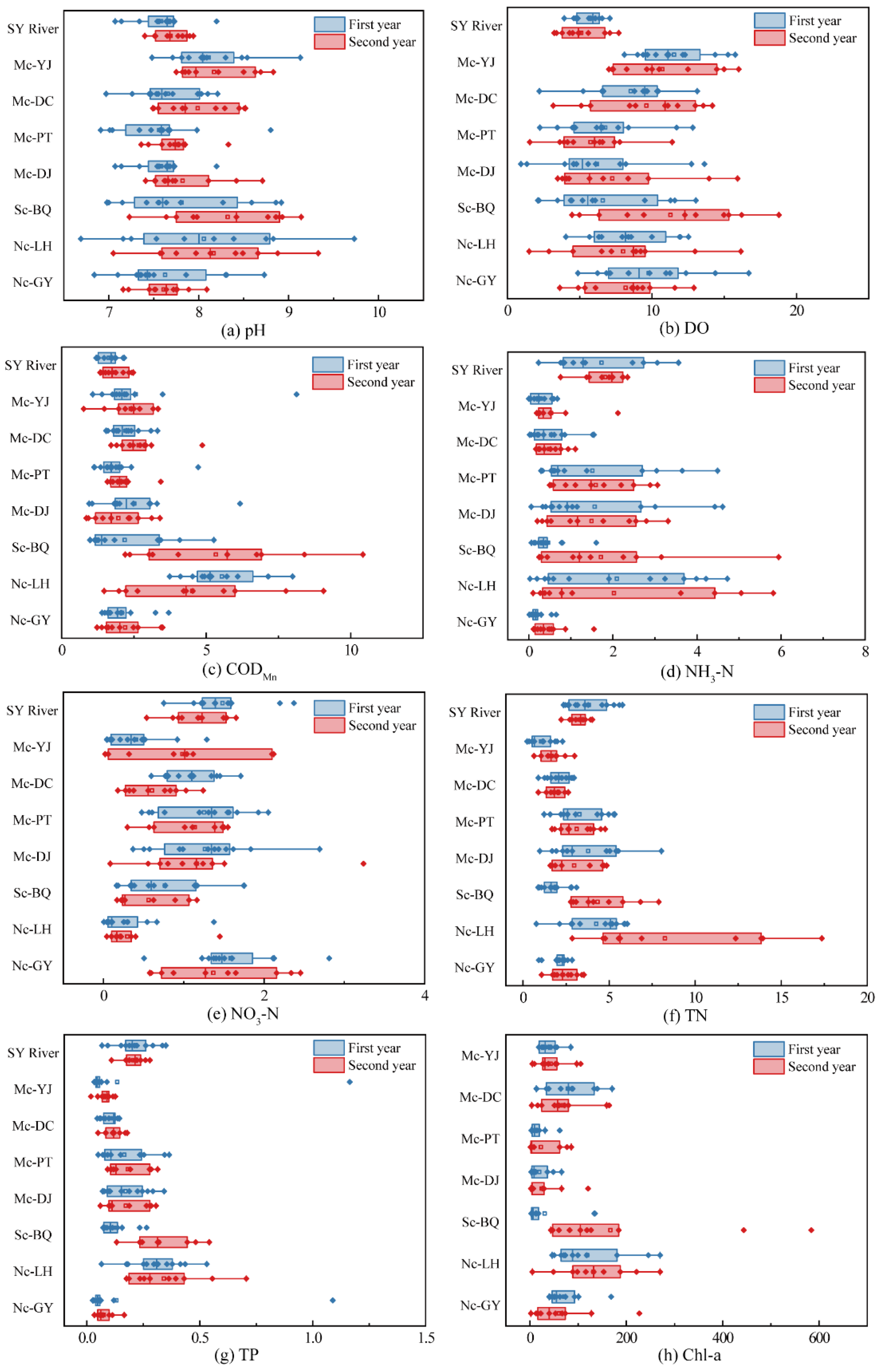

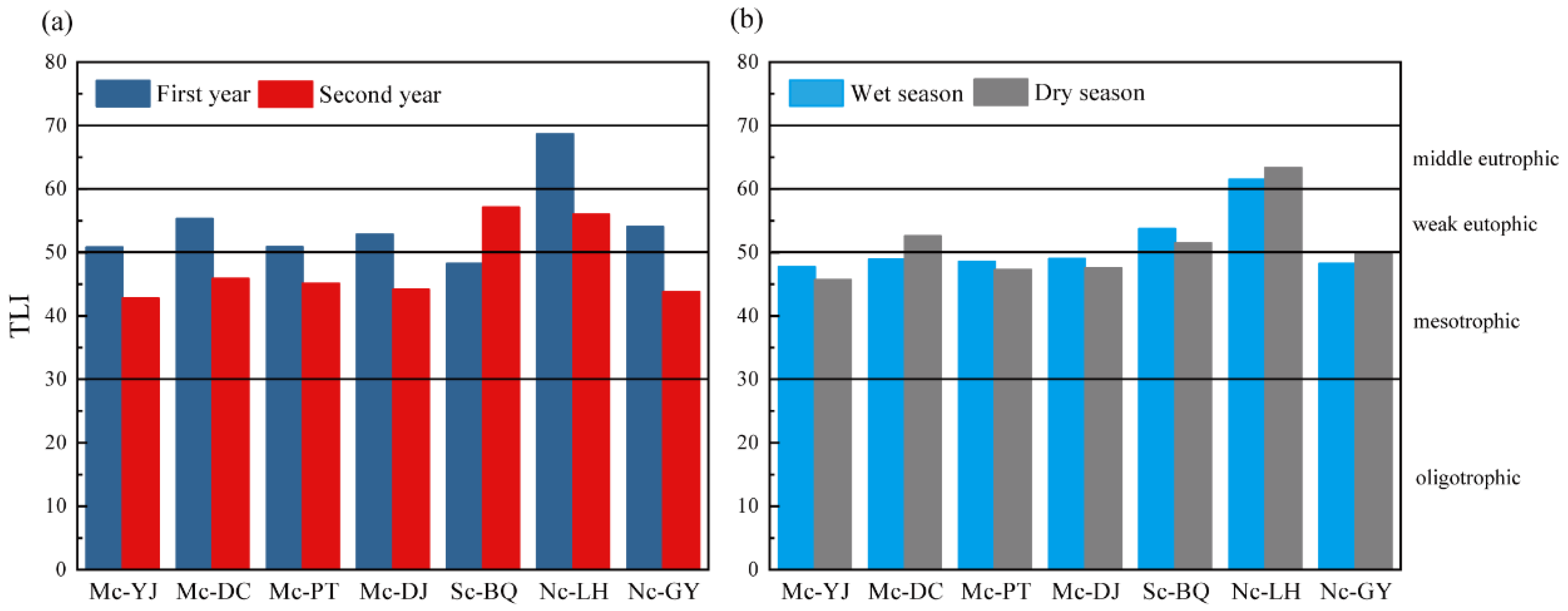
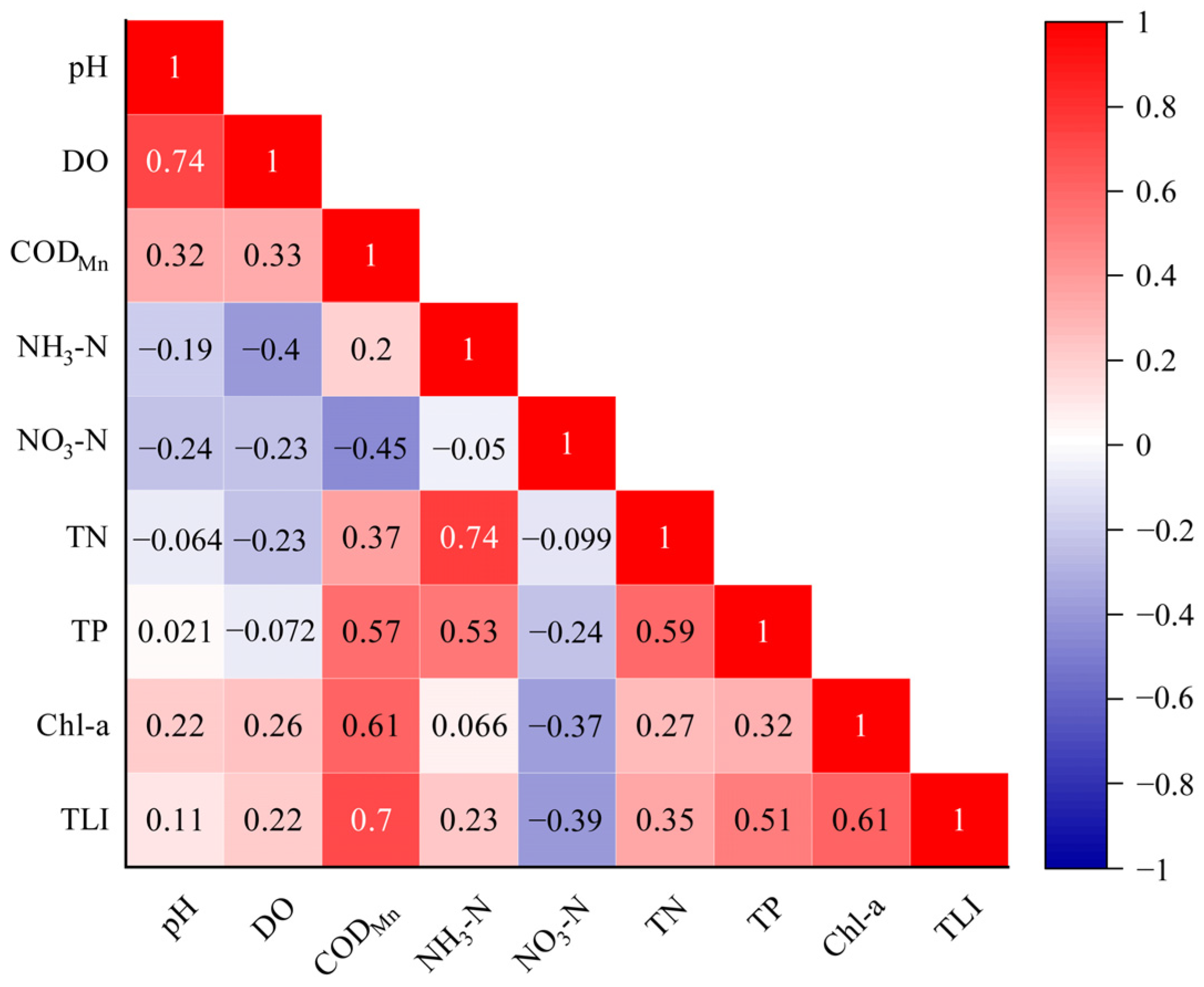


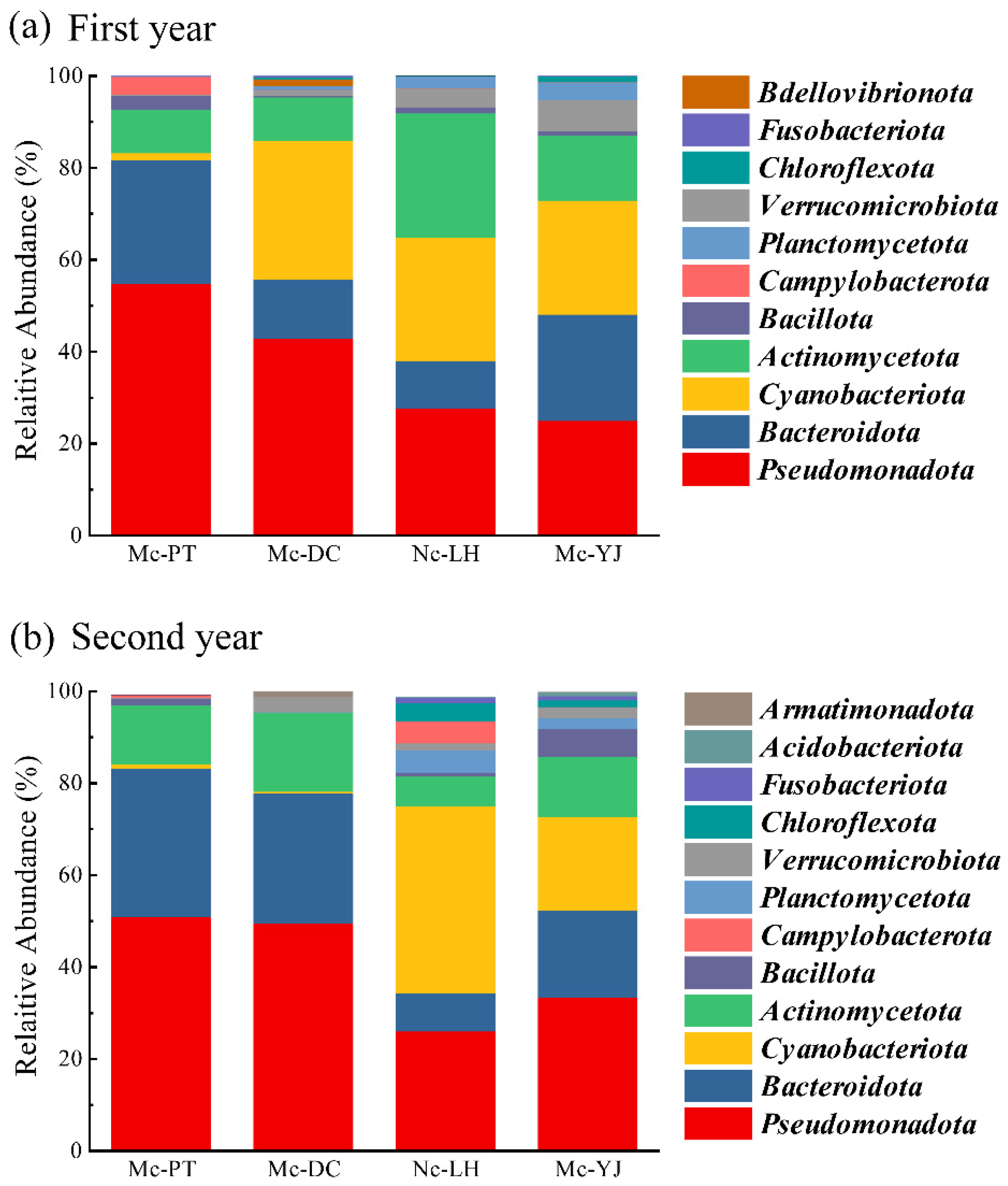
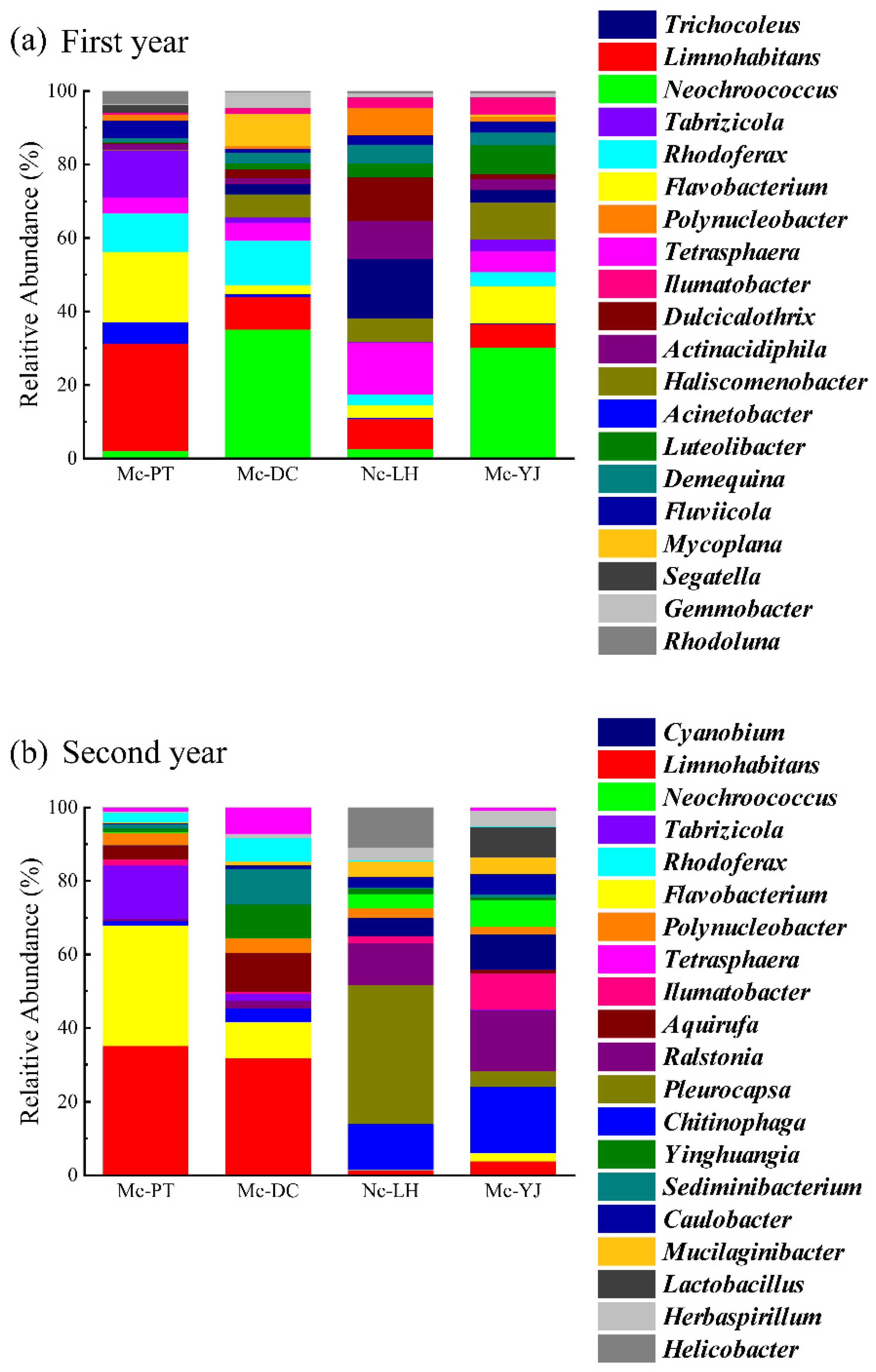
Disclaimer/Publisher’s Note: The statements, opinions and data contained in all publications are solely those of the individual author(s) and contributor(s) and not of MDPI and/or the editor(s). MDPI and/or the editor(s) disclaim responsibility for any injury to people or property resulting from any ideas, methods, instructions or products referred to in the content. |
© 2025 by the authors. Licensee MDPI, Basel, Switzerland. This article is an open access article distributed under the terms and conditions of the Creative Commons Attribution (CC BY) license (https://creativecommons.org/licenses/by/4.0/).
Share and Cite
Liu, H.; Huang, S.; Chen, H.; Zuo, M.; He, G.; Wang, M.; Bai, S.; Zhang, Q.; Xu, D.; Ding, Y.; et al. Study on the Effect of Water System Connection on the Improvement of Water Quality of Inner Lakes in Town—Taking Seven Lakes in Yangshuo Urban Area of Guilin as an Example. Water 2025, 17, 1398. https://doi.org/10.3390/w17091398
Liu H, Huang S, Chen H, Zuo M, He G, Wang M, Bai S, Zhang Q, Xu D, Ding Y, et al. Study on the Effect of Water System Connection on the Improvement of Water Quality of Inner Lakes in Town—Taking Seven Lakes in Yangshuo Urban Area of Guilin as an Example. Water. 2025; 17(9):1398. https://doi.org/10.3390/w17091398
Chicago/Turabian StyleLiu, Huili, Shuhai Huang, Hang Chen, Mingbo Zuo, Guangyan He, Mei Wang, Shaoyuan Bai, Qin Zhang, Dandan Xu, Yanli Ding, and et al. 2025. "Study on the Effect of Water System Connection on the Improvement of Water Quality of Inner Lakes in Town—Taking Seven Lakes in Yangshuo Urban Area of Guilin as an Example" Water 17, no. 9: 1398. https://doi.org/10.3390/w17091398
APA StyleLiu, H., Huang, S., Chen, H., Zuo, M., He, G., Wang, M., Bai, S., Zhang, Q., Xu, D., Ding, Y., & Zhang, Y. (2025). Study on the Effect of Water System Connection on the Improvement of Water Quality of Inner Lakes in Town—Taking Seven Lakes in Yangshuo Urban Area of Guilin as an Example. Water, 17(9), 1398. https://doi.org/10.3390/w17091398





